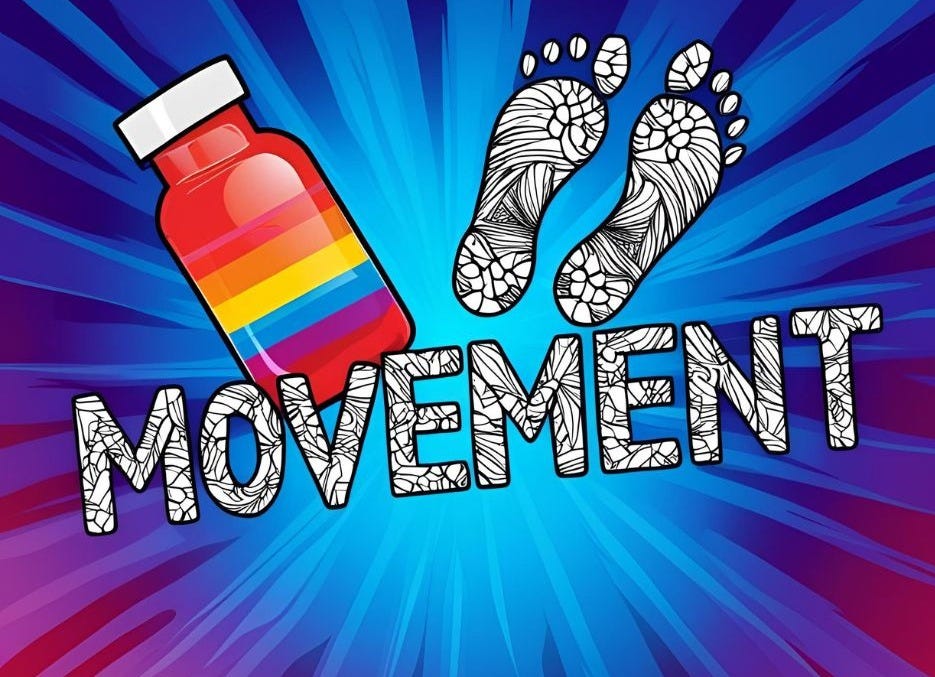We’ve all heard the advice to “get more exercise.” Maybe you diligently hit the gym, go for a morning walk, or follow an online yoga session. That’s great! However, research shows that even dedicated daily exercise—30 to 60 minutes—can’t fully counteract the health risks of prolonged sitting throughout the day.
The evidence is clear: our bodies are designed for regular movement, not just bursts of exercise followed by extended stillness. Regular movement is even more important for older adults and postmenopausal women, who face elevated health risks from sedentary behavior.
But fear not! You don't need to overhaul your lifestyle. Simply by incorporating small, frequent movements—exactly what your body is designed for—you can profoundly impact your metabolism, longevity, and overall well-being.
The Hidden Dangers of Sitting Too Much
Modern life makes it easy to sit for hours—working at a desk, watching TV, scrolling on your phone. While these sedentary habits feel comfortable in the moment, prolonged sitting wreaks havoc on your body, increasing the risk of:
Heart disease – Even regular exercisers are at higher cardiovascular risk if they sit too much, according to a study in JACC Journals.
Diabetes – Sitting too long reduces insulin sensitivity. A 2023 Journal of Clinical Endocrinology & Metabolism study found that breaking up sitting with 5 minutes of walking every 30 minutes improved insulin response by 58%.
Obesity and metabolic syndrome – Prolonged sitting slows calorie burn, alters metabolism, and increases inflammation (Medical Science Monitor).
Muscle and joint issues – Staying seated weakens muscles, tightens hips, and can lead to chronic pain.
Cognitive decline – A 2022 JAMA Neurology study found that taking 3,800–9,800 steps daily was linked to lower dementia risk.
Key Takeaway: Regular exercise is important, but if you sit most of the time you’re still at risk for serious health problems.
The Metabolic Magic of Movement (and Why It Matters More with Age)
What makes frequent movement so powerful? It’s all about how your body processes glucose.
As we age, we naturally lose muscle mass (sarcopenia), and since muscles are the body’s primary “glucose sponges,” this reduces our ability to clear glucose from the bloodstream. The result? Higher blood sugar levels, increased inflammation, and a greater risk of metabolic disease.
What many don’t realize is that even brief, gentle movement activates a special glucose uptake pathway that works independently of insulin. Simply contracting your muscles—through standing, walking, or stretching—triggers:
✅ Rapid glucose absorption into muscle cells
✅ Lower blood sugar levels
✅ Reduced inflammation
✅ Improved energy at the cellular level
This happens within minutes of movement—no intense exercise or heavy weight lifting is required! Just standing up and walking for a few minutes can ignite your metabolism.
For older adults, these frequent “movement snacks” become even more critical for counteracting muscle loss and maintaining metabolic health.
The Distinction Between Exercise and Movement
Like many people, I used to think that my daily “workout” was all I needed to stay fit and healthy, even though I spent most of my day sitting at my desk. Notably, there’s a key difference between exercise and movement:
Exercise = Structured activity (gym, fitness class, running, yoga)
Movement = Everyday activity (walking around, stretching, housework, standing)
Working out for an hour but remaining sedentary the rest of the day comes at a price, and research published in the American Journal of Epidemiology confirms that a daily workout doesn’t negate the harmful effects of prolonged sitting.
How Much Movement Do You Really Need?
The latest research suggests frequency matters more than duration. A 2023 Medicine & Science in Sports & Exercise study found that taking a 5-minute movement break every hour improved metabolic markers better than a single 30-minute workout followed by prolonged sitting.
Move every 30 minutes – Just 2-3 minutes of movement lowers blood sugar and improves circulation.
Stand for 3+ hours per workday – Can reduce cardiovascular risk by 25%.
Get 5-10 minutes of light activity every hour – Can cut mortality risk by 50%.
Key Takeaway: You don’t need more intense “workouts”—you need more frequent movement.
Why This Matters Even More for Postmenopausal Women
The hormonal challenges faced by postmenopausal women make frequent movement even more important for several reasons:
Accelerated muscle loss – After menopause, women can lose muscle mass more rapidly, further reducing the body’s capacity to clear glucose.
Weight gain– Hormonal changes after menopause can slow down metabolism, making weight gain more likely.
Increased risk of osteoporosis – Weight-bearing movement (like walking) is essential to maintain bone density.
Higher cardiovascular risk – Women’s risk for heart disease rises sharply after menopause, making movement a key factor in maintaining heart health.
Greater insulin resistance – Hormonal changes after menopause can increase insulin resistance, making those movement-activated glucose pathways particularly important.
The American Heart Association reported that older women who walk as little as 2,100 steps per day reduced cardiovascular-disease risk, and increasing that number to over 4,500 steps per day, further improved heart health. Notably, these benefits were observed regardless of walking speed, emphasizing that simply moving more—without necessarily engaging in intense exercise—plays a significant role in longevity.
Key Takeaway: If you’re postmenopausal, moving more throughout the day is one of the best things you can do for your long-term health.
Overcoming Common Challenges to Moving More
Even with the best intentions, adding more movement to your day can be challenging. Here’s how to tackle common obstacles:
1. “I get engrossed in something and forget to move.”
✅ Solution: Set a reminder every 30 minutes or use a smartwatch for movement nudges.
2. “I don’t have time.”
✅ Solution: Stack movement onto existing tasks—walk or march in place while talking on the phone, do calf raises while waiting for coffee, perform leg extensions while watching TV. Even standing up is better than staying glued to your chair.
3. “I work at a desk all day.”
✅ Solution: Stand during phone calls, use a standing desk, or take a quick hallway walk between meetings.
4. “I feel silly moving so often.”
✅ Solution: Frame it as a non-negotiable health habit—just like brushing your teeth.
5. “I’m too tired.”
✅ Solution: Low energy is often a sign you need more movement, not less! Start small—2-minute walks can boost energy and metabolism.
Simple Ways to Move More (Without Overhauling Your Day)
The best way to move more? Make it easy and automatic. Here are some simple ways to sneak in extra movement:
🔹 Set a timer – Stand up or move every 30 minutes.
🔹 Walk while on calls – Get steps in while talking.
🔹 Re-think TV time – Stretch, do leg lifts, or march in place.
🔹 Squat while brushing your teeth – A two-minute strength habit.
🔹 Take the long way – Park farther away, take the stairs, or walk around your house.
🔹 Try “exercise snacking” – Do 10 squats, a quick flight of stairs, 30 seconds of marching in place throughout the day, or play a favorite song and dance to it.
Do I Still Need To Exercise if I Move More Throughout the Day?
In short—yes. While incorporating short bouts of movement throughout your day is essential, it doesn’t replace the need for structured exercise. Structured exercise provides additional benefits that spontaneous movement alone doesn't fully cover, such as improving cardiovascular fitness, building strength, and enhancing endurance. The two serve different but complementary purposes.
Research strongly supports this combination approach. A study from the American Heart Association found that adults who engaged in at least 150 minutes of moderate to vigorous exercise per week had a 67% lower risk of death from any cause. However, even light-intensity activities—like household chores or casual walking—were associated with a 20% lower mortality risk for every additional 30 minutes of movement. On the other hand, each additional 30 minutes of sedentary behavior raised the risk of dying by 32%.
Exercise and movement together create a winning formula. Structured workouts strengthen muscles, improve heart health, and enhance mobility, while frequent movement throughout the day counteracts the harmful effects of being sedentary.
Key Takeaway: Exercise helps you thrive, and movement helps you survive. Together, they’re a powerful strategy for adding not just years to your life—but life to your years.
How Much Exercise Do You Need?
To maximize the benefits of both movement and structured exercise, experts recommend:
✔️ 150 minutes of moderate-intensity aerobic activity per week (like brisk walking, dancing, or swimming) OR 75 minutes of vigorous activity (like running or hiking).
✔️ Muscle-strengthening exercises at least twice a week to maintain strength and independence.
✔️ Balance and flexibility training (like yoga or tai chi) to reduce fall risk.
A recent study in the British Journal of Sports Medicine found that regular exercise can add up to five extra years to your life. Researchers analyzed data on physical activity and longevity and concluded that the most sedentary individuals had the most to gain. Exercising regularly and engaging in consistent movement contribute to a longer and healthier life
Think of it this way: movement throughout the day keeps the engine running, but structured exercise keeps it strong and efficient. Aim for both!
Join the Movement: Try a 30-Day Movement Challenge
Right now, I’m running a workplace wellness challenge where participants commit to moving more and sitting less—even if that just means taking short movement breaks throughout the day.
The results so far? More energy, better focus, and fewer aches from sitting too long. It’s proof that small, consistent movement adds up!
Why not try it yourself? Challenge yourself to five movement breaks a day for the next 30 days. It can be as simple as:
✅ A 30-second march in place
✅ 10 squats or toe raises
✅ A quick hallway or backyard walk
✅ Stretching at your desk
Track your progress using a checklist, timer, or app and celebrate wins—you might be surprised at the difference it makes!
The goal isn’t to add stress to your day—it’s about reclaiming the natural movement your body thrives on. The more you move, the better you'll feel. And remember, small changes add up to big results.
💡 Want a little extra accountability? Download and print my Movement Challenge Tracker!
What small movement habit can you start today? Let me know in the comments! 🚶♀️💙









That's an interesting question, Elizabeth. When you're rocking vigorously in a chair, you're activating your muscles. I just tried rocking in my office chair, and I felt my core engage. You say that you're also using your arms and legs. So, I don't think you're kidding yourself. It counts as movement. And if it makes you feel good, that's reason enough to continue doing it!
Hi, this may be a very silly question. I have arthritis and stenosis. I am diligent in moving often in short bursts -- walking circuits around my house, climbing stairs for the heck of it, stretching, dancing for 10 minutes. But I've noticed something odd -- I feel most flexible after I've sat in a chair and rocked with vigor for 30 minutes. Can rocking in a chair while doing leg and arm stretching count as movement, or am I only kidding myself?